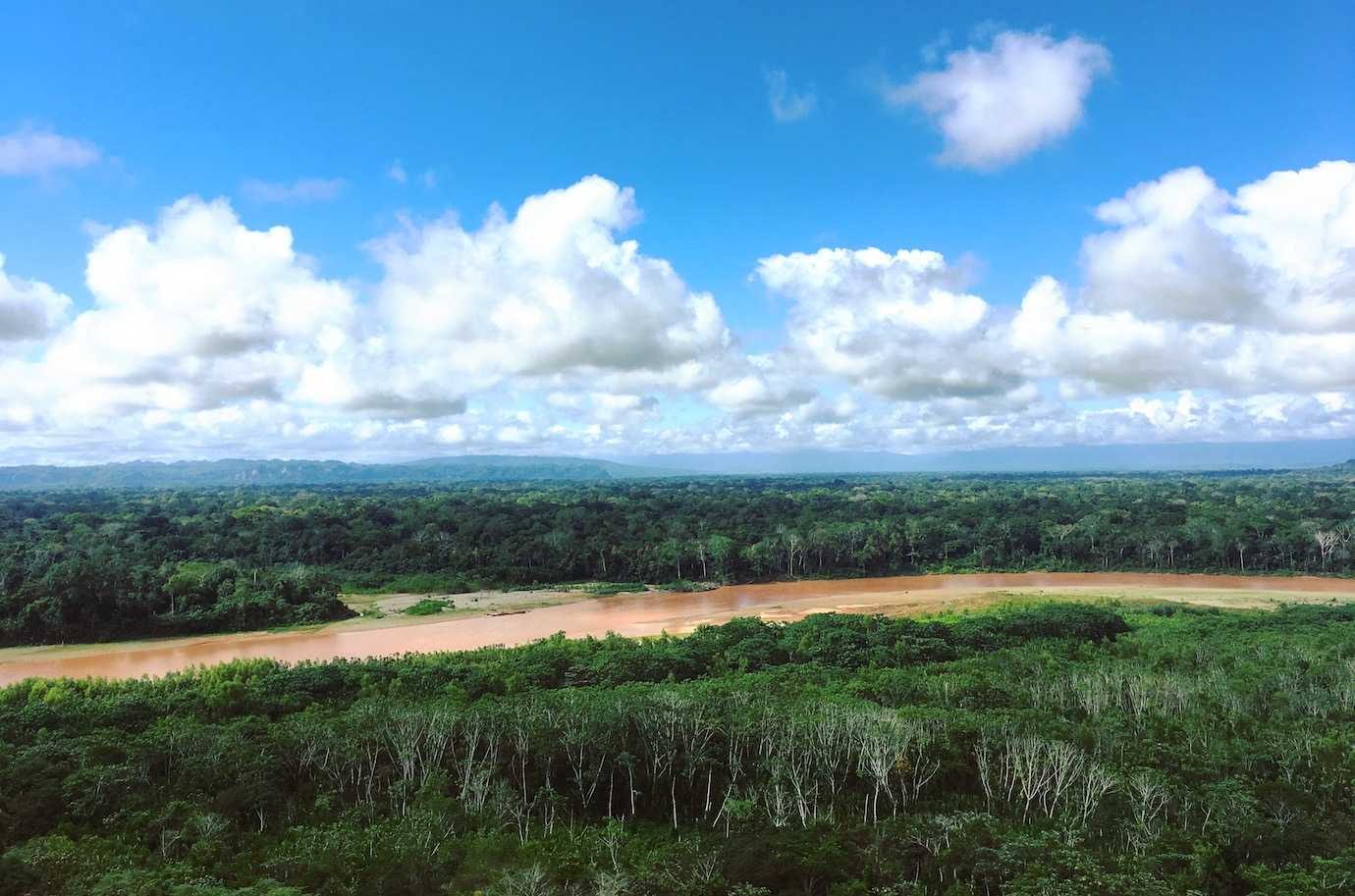
Spanning an area of 5,500,000km², the Amazon occupies the heart of South America with Brazil, Peru, Bolivia, Colombia, Ecuador, Venezuela, Guyana, Suriname and French Guyana all claiming their own piece. Representing over half of the planet’s remaining rainforests, the Amazon Rainforest is the largest and most biodiverse tropical rainforest in the world.
Why Rurrenabaque?
Setting foot in the Amazon features on many peoples’ bucket lists. With so many countries offering a gateway into the Amazon (e.g. Puerto Maldonado and Iquitos in Peru and Manaus in Brazil), it’s hard to choose where to go. Being home to 60% of it, Brazil is often the obvious choice.
We didn’t go with Brazil and instead chose to experience the Amazon in Bolivia, more specifically from Rurrenabaque – a small town in northern Bolivia on the Beni River with easy access into the Madidi National Park.
We chose Rurrenabaque (or Rurre as it’s shortened to) for two main reasons. Firstly, it fit into our travel plans better than say Brazil’s Manaus or Peru’s Puerto Maldonado, and secondly we were travelling on a budget and our money went further in Bolivia.
How to get to Rurrenabaque
The two main ways of getting to Rurre are by bus or plane. The bus, often described as gruelling and not for the faint hearted, can take around 18 hours and even longer on a bad day. Definitely not the option for those tight for time! Most don’t recommend the bus in the wet season either due to the narrow, windy and unpaved roads.
The bus is a night one and leaves from La Paz around mid-afternoon and arrives (hopefully) to Rurre early the following morning. Despite hearing stories about the length of the journey and the narrow roads, we chose to get the bus to Rurre to save some money. Instead of getting it from La Paz, we hopped on it at Coroico, a small town in the Yungas where we spent two days after biking Death Road, which probably knocked off three hours from our total journey time.
We paid just under Bs 100 (approx £10) for our ticket and I remember being pleasantly surprised at how fast we got to Rurre. Now “fast” is all relative but compared to the horror stories we’d heard, we definitely had a smooth 11 hour ride which I managed to sleep on!
Flying from La Paz to Rurre is the other – I reckon more favourable – option. Amazonas flights fly several times a day, last 30 minutes and cost around the £80 mark. It’s almost a no brainer, yet at the time we reasoned the bus was worth the money we’d save. Sound logic right?!
You might be pleased to hear that we didn’t repeat the bus journey back to La Paz. We did splash out on a flight back to continue our travels onwards to Brazil and marvelled at how quick it was. One minute we were flying over the Amazon, next we were landing at La Paz’s El Alto. The flights can occasionally be subject to time changes as a girl at our hostel found out but they contacted her letting her know in advance.
Choosing an Amazon tour – Jungle or Pampas
First off, don’t book a tour online. The internet is great to research and get a feel for what’s available, but when it comes to booking a tour you’ll find inflated and expensive prices. Wait to book your tour in Rurrenabaque with a local agency where you can get good prices, double check what’s included in your tour package and be sure they actually exist. Don’t worry about availability, you can book your tour the day before you go – we did that and it was all fine.
There are two tours available in Bolivia’s Amazon: Jungle or Pampas. The Jungle tour takes you into the rainforest and focuses on hiking in the jungle and learning about the flora and fauna that live there. The Pampas tour is based around the Amazon’s swamps and rivers and focuses on wildlife viewing.
Both tours have flexible durations, jungle tours can last for 30 nights if you’re so inclined. A two hour boat ride for the jungle and a three hour drive to the Pampas is needed to get to the lodges, which are further in the Amazon.
Deciding which tour to do can be tricky and it took us ages to make our minds up. Originally, my friend and I were fully sold on the jungle tour. It made complete sense; we’d after all come to the Amazon rainforest. Of course we wanted to experience and set foot in it.
Speaking with other travellers however seemed to start us doubting our choice as the Pampas tour seemed to be the more popular of the two. Sat in our tour agency’s office indecision hit us. We didn’t want to go the Amazon and not set foot in the jungle, yet at the same time the general consensus was that the Pampas was the most rewarding wildlife wise.
Thankfully, we didn’t have to choose one or the other. We were able to book a four day combined jungle/pampas tour spending two days in each. See below for a breakdown of our four day experience.
Our four day jungle and pampas tour
Day One – Into the rainforest
Tip 1: You won’t want to take all your luggage with you, it’s not practical. You can leave the rest of your belongings at your agency’s office and simply take a small day rucksack with the bare essentials and a few changes of clothes. We left our large backpacks at our hostel.
Tip 2: When packing for the Amazon jungle, pack a pair of long trousers. You’ll be walking through the jungle’s undergrowth and it’s best to be covered. Agencies recommend long sleeves too, although we were fine in t-shirts.
Tip 3: The tropical Amazon is home to an abundance of mosquitos and other insect biters. Take insect repellent to reduce your chances of getting bitten. We were also taking anti malarials for the duration of our time in Rurrenabaque and the Amazon – better safe than sorry was our view.
Picked up at 8am from our hostel by our guide we were taken to Rurre’s riverbank for the boat ride into the Amazon and Madidi National Park, stopping once along the way to learn, make and try sweet sweet sugar cane. At the lodge, we had lunch and then went for our first wander in the jungle.
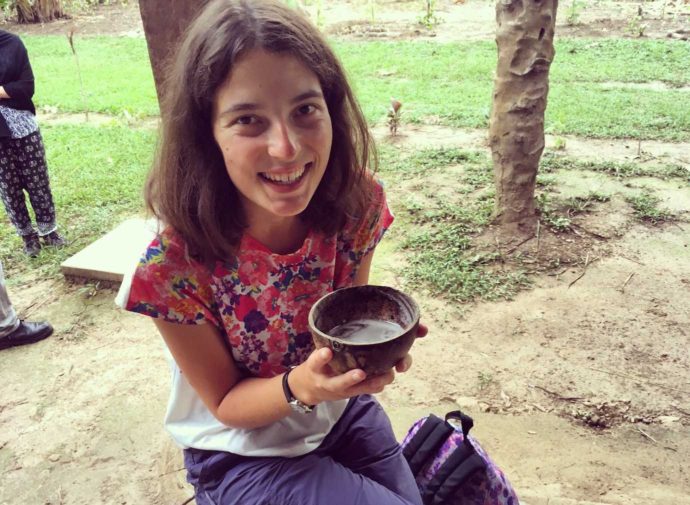
Tip 4: Tuck your trousers into your socks when walking to avoid creepy crawlies from climbing up your legs.
The biodiversity that exists in the Amazon is absolutely incredible, it’s such an amazing place. Walking past 400 year old trees really drives home how old this rainforest is and made me feel extremely young.
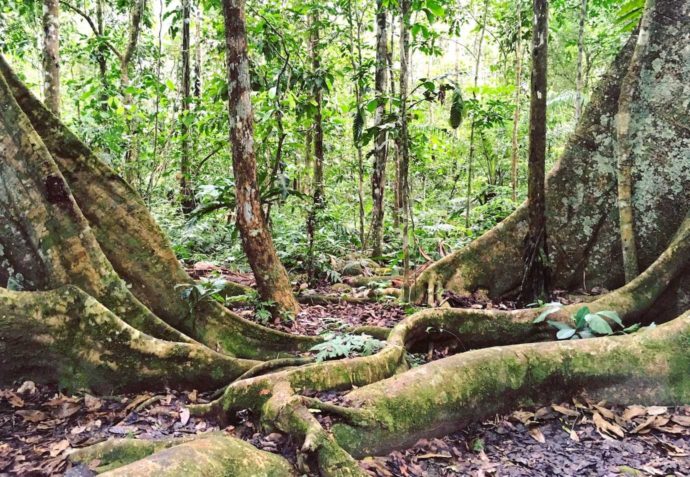
Sharing tips on how to behave in the Amazon, our guide’s favourite phrase was that ‘the forest itself isn’t dangerous, it’s us knowing how to act in it’. On our walk, we learnt about the different types of forest as well as some plants’ special medicinal properties which local communities use.
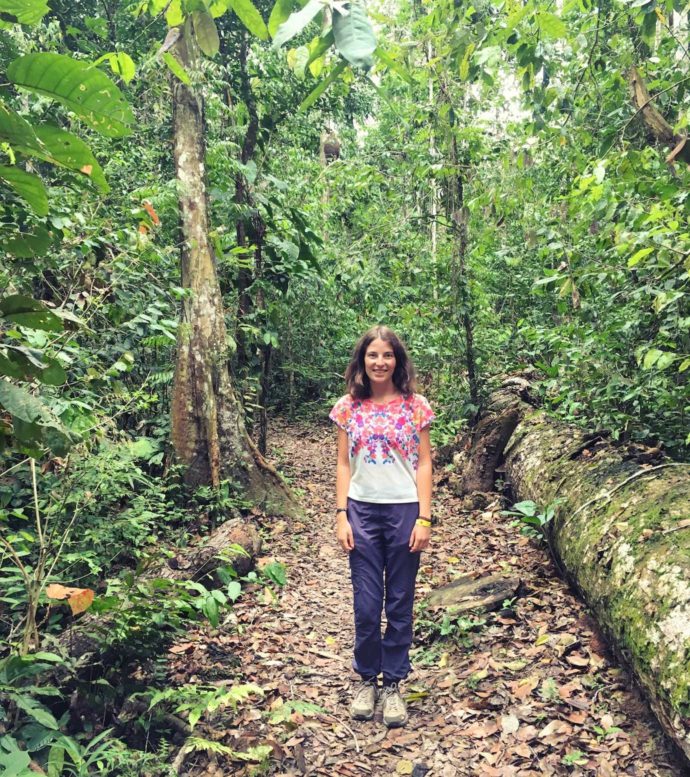
When night had fallen we went out for a post dinner night walk. With phone torches lighting our way, we trailed through the forest seeking the nocturnal night life. It was great to see the jungle at night and I just had to ignore my jumpiness and spider fears.
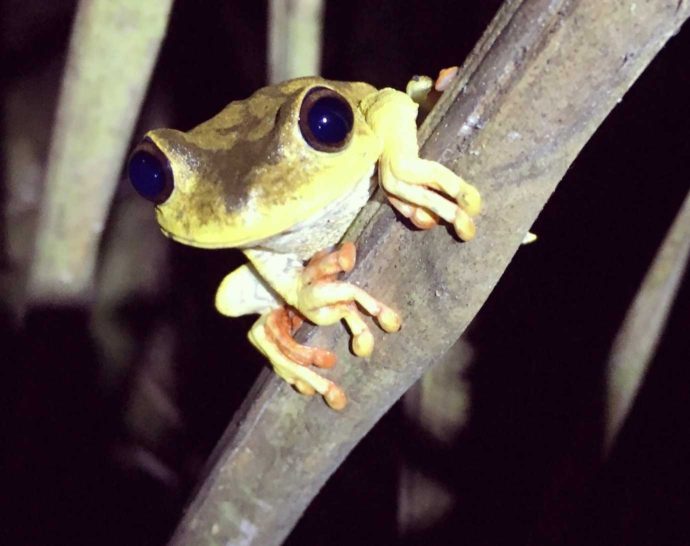
Bumped into this cute little fellow!
Day Two – in the rainforest
We walked deeper into the jungle on Day Two, stopping for lunch at a more basic camp*. It was around a three hour walk to the camp and we saw howler monkeys, toucans and hummingbirds high in the tree tops on route. The jaguar remained as elusive as ever.
Walking in the Amazon for me was a surreal experience. At ground level it felt like any tropical forest. It was when the trees parted to show those epic Amazon views that I had those pinch me moments of ‘I’m in the in the Amazon!’.
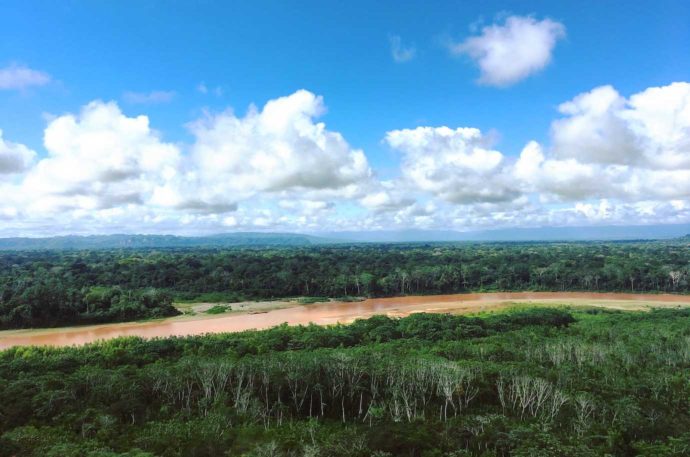
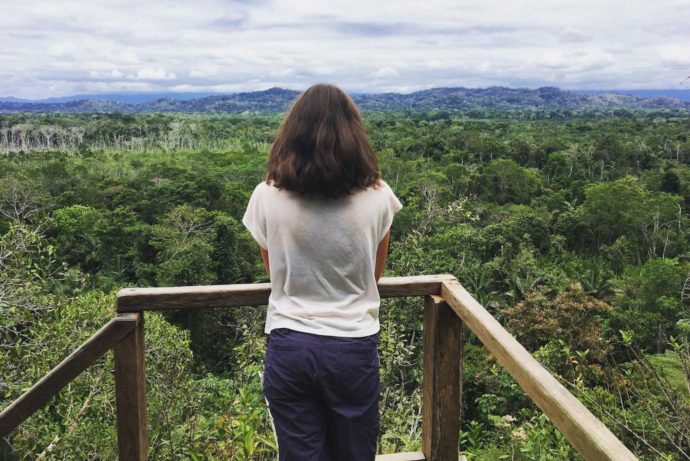
In the afternoon, we climbed a viewing platform to watch brightly coloured Macaw parrots flying in and out of their cliff face nests. Did you know they mate for life? We then went to build our raft on the river – I can say I’m not much of a raft builder – and paddled back to our lodge. Floating down the river surrounded by the Amazon rainforest was my highlight that day. I’d never pictured myself doing that and it was beautiful.
*We did have the option to stay at the more basic camp for our second night but as a group we decided to stay at the lodge.
Day Three – Out of the jungle and into the Pampas
It was time to leave the jungle and see the Pampas. After an early breakfast, we got the boat back to Rurre and hopped into a car for the transfer to the Pampas. Due to a protest blockading the road, our transfer was slightly delayed as we had to wait for another car to collect us from the other side of the blockade.
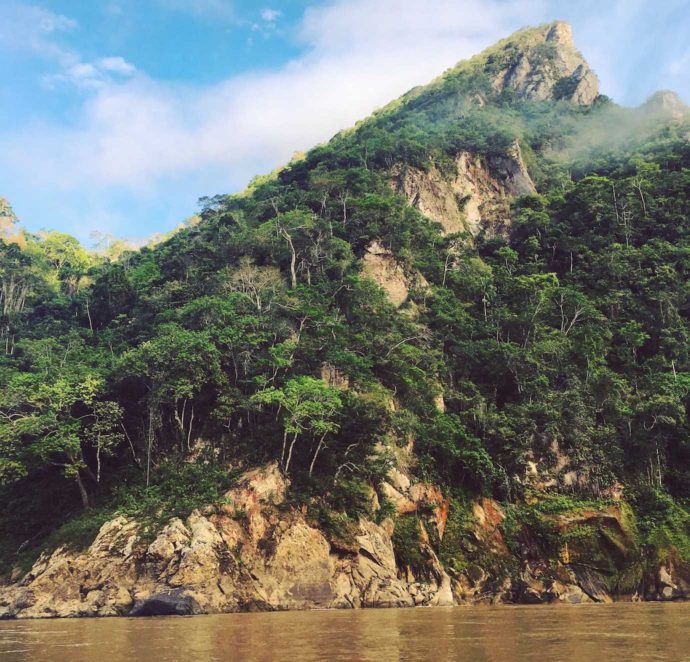
Leaving the jungle and heading to the Pampas
On arrival to our Pampas lodge, we were greeted with fresh juice, shown our rooms and then had lunch. We got to test the hammocks out after lunch before our afternoon boat trip.
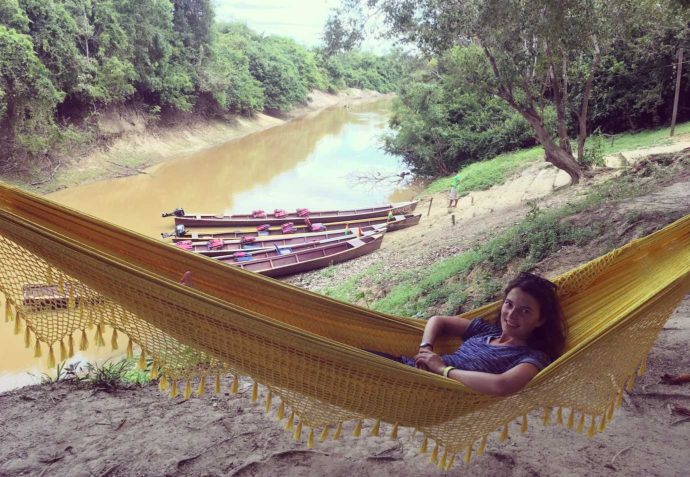
We saw so much wildlife: (I swear) hundreds of caiman in the water, families of capybaras lined the river bank and exotic birds sat in the trees.
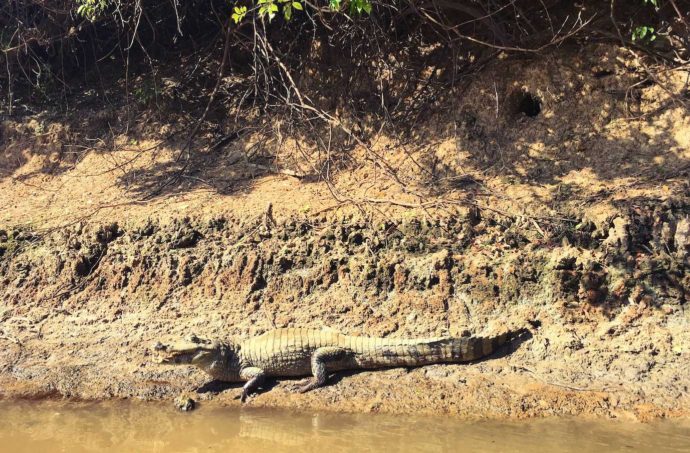
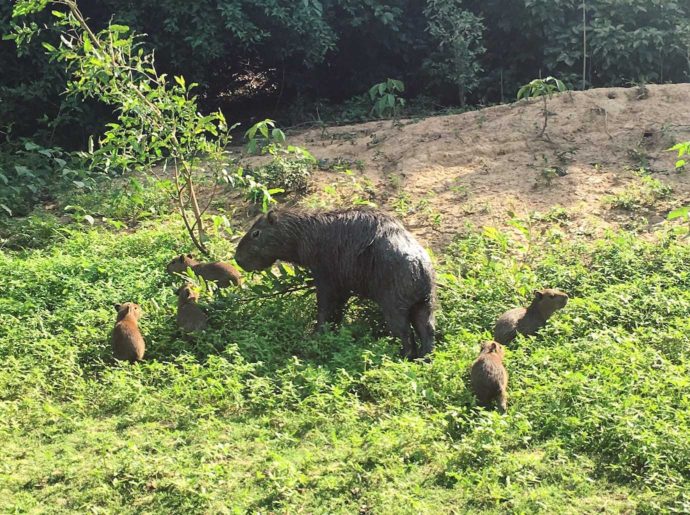
Further down the river, we saw cute yellow squirrel monkeys and had a go at fishing for piranhas.
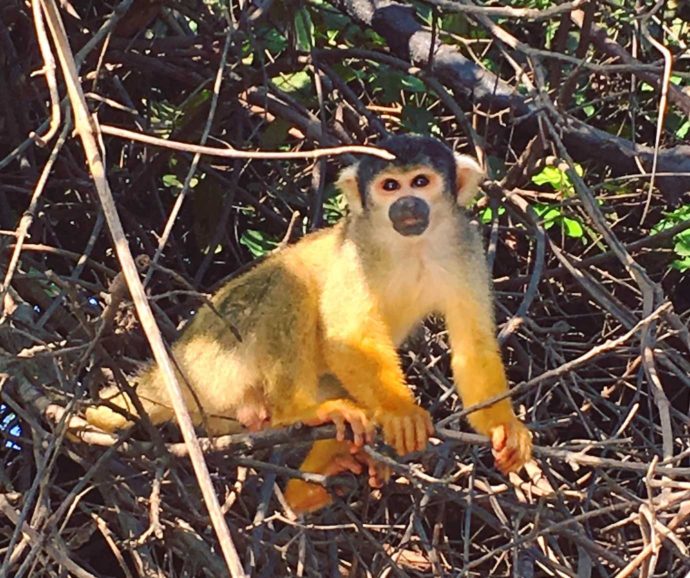
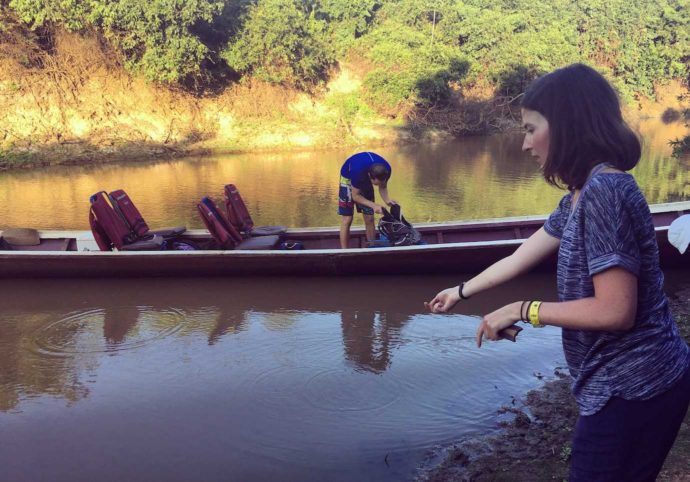
Having never fished before I wasn’t originally sold on piranha fishing. Within minutes of catching my first piranha I took it all back quickly becoming the keenest one there. I was very proud of my total catch of five, although I think my technique, whipping the line out and flinging piranhas into the bushes and trees, left much to be desired.
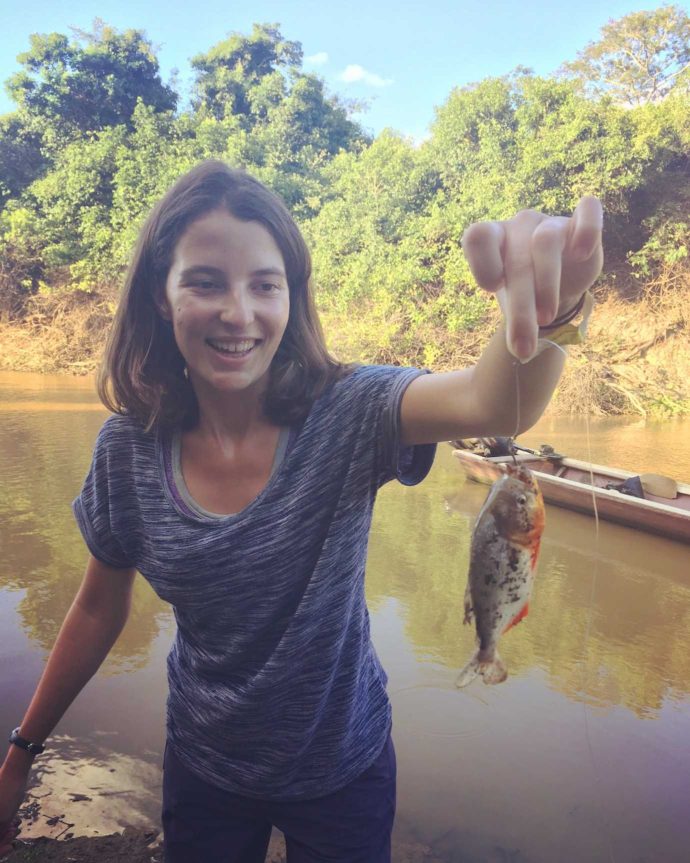
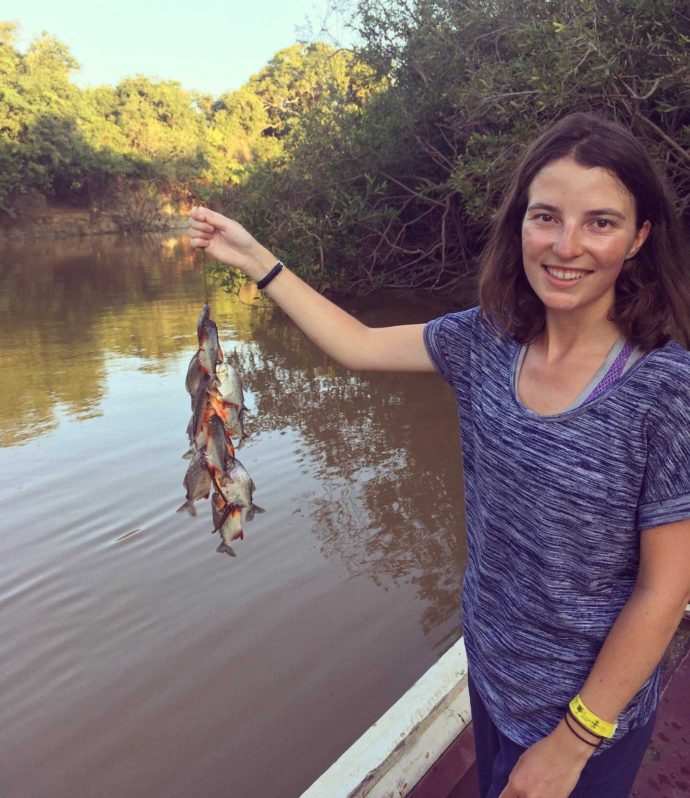
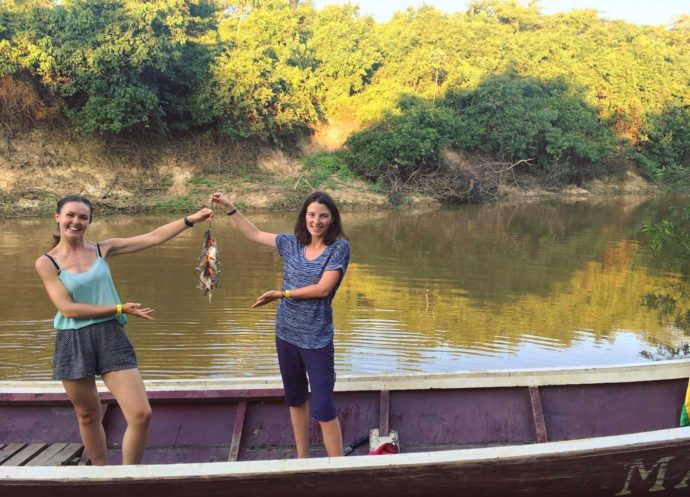
With the afternoon drawing to a close, we headed back along the river to our lodge stopping off the climb the riverbank to view the setting sun. So beautiful!
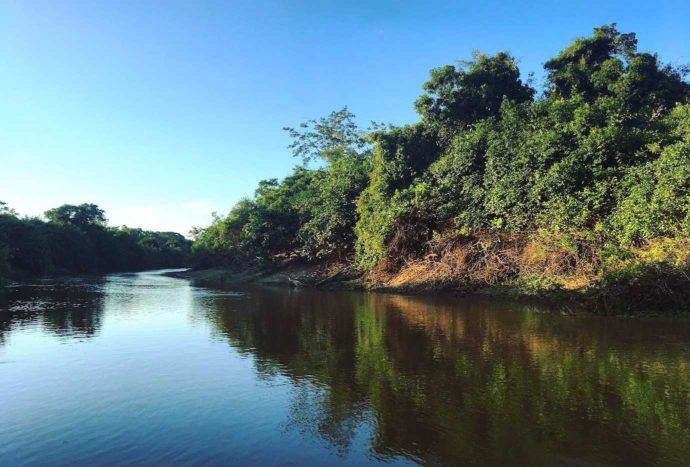
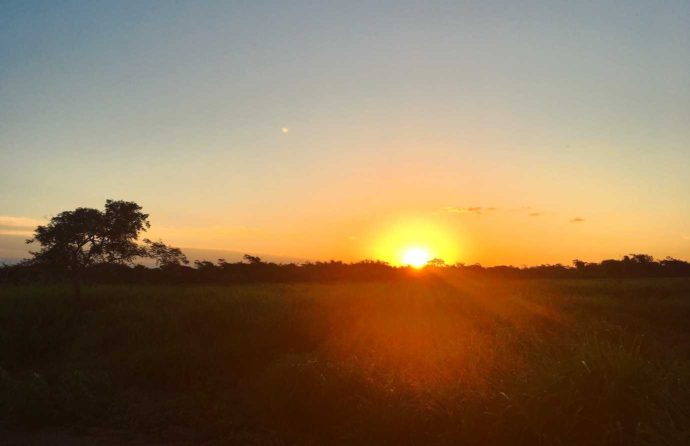
For dinner, we got to eat the piranhas we’d caught earlier and had a delicious macaroni cheese – my first in South America.
Like the night walk in the jungle, we went on a night boat trip. Seeing the caimans’ eyes glowing red in the torchlight was eery. I loved how calm everything was. I’m also a goner for starry night skies and floating on a boat in the dark gazing up at the wide star filled night sky was extremely special.
Day Four – Last day in the Pampas
In the morning, we went on one last excursion: searching for anacondas in the marshy wetlands. Wearing knee high rubber boots we squelched our way through the high grasses in the hope and fear of coming face to face with an anaconda. Not finding any you could say we were unlucky, although I see it as lucky!
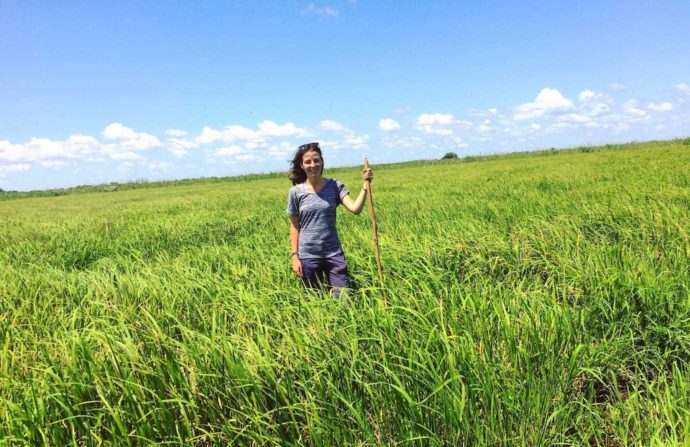
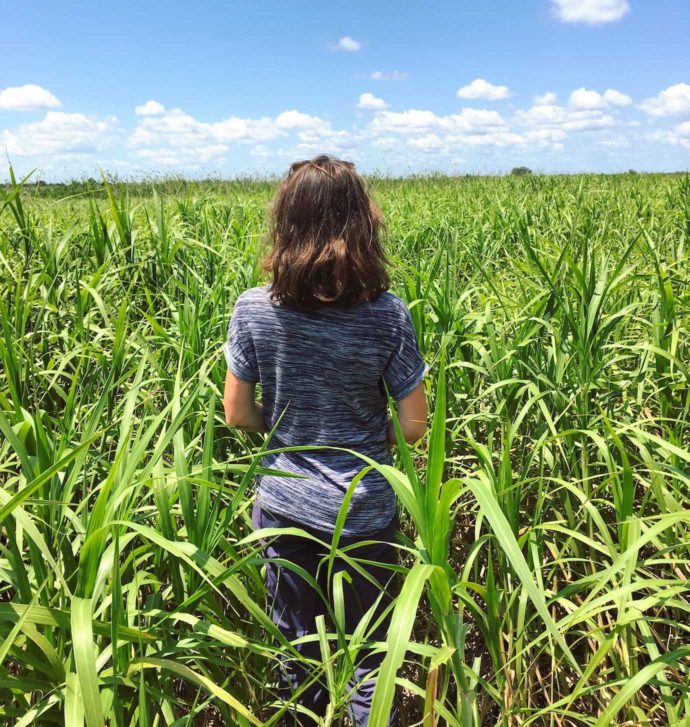
On the way back to the lodge a small pod of pink river dolphins made an appearance.
Tip 5: A lot of other tour agencies advertise swimming with pink river dolphins. Do check with your agency whether it’s the right season to swim with them and safe. We asked our agency before going and were told it wasn’t safe in the dry season as the river is full of caiman in a dense area. Having seen the number of caiman in the water and how quickly we caught piranhas, I wasn’t hugely fussed about getting in the water. That said, many people spoke about swimming with the dolphins at our hostel despite our agency saying it wasn’t safe. Ultimately it’s your agency’s and your decision.
Following lunch at the lodge, we were transferred back to Rurre and our four day jungle/pampas adventure came to an end.
Final thoughts on our Amazon jungle and pampas experience
So jungle or pampas – which one or both?
We didn’t see as much wildlife as we would have liked during our two days in the rainforest. The rainforest is the perfect place for animals to blend in and hide so our wildlife quota was more limited to insects, birds and the occasional monkey high in the distant tree tops. There’s always the chance you might get lucky, but sightings can’t be guaranteed and more often than not the animals remain as elusive as ever.
I still really enjoyed our time in the rainforest, simply being in the Amazon Rainforest was a surreal experience for me. Combine that with rafting along the river, night walks and gazing at the epic starry night sky and I’ve got a great jungle memory to treasure.
The Pampas tour was teeming with wildlife from start to finish. It’s much more rewarding in that sense, so if you only have time for one tour and you’re after wildlife, then the Pampas is for you.
I’m super glad we got to experience both jungle and pampas. It felt like we got the best of both and I do have a feeling that if we’d only done jungle we might have ended the tour feeling a little flat on the wildlife front. Going to the Pampas after the jungle really fulfilled our wildlife quota. If you’re thinking of doing a combo tour, I’d recommend visiting the jungle first and then the Pampas.
Wherever you go the Amazon is an amazing place to experience, it just has that special something. My visit to the Amazon is definitely a highlight from our travels in Bolivia and South America.
Have you been to the Amazon? Which country did you visit it from? Did you do Pampas or Jungle (or both)?